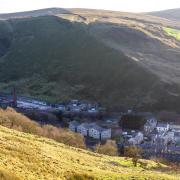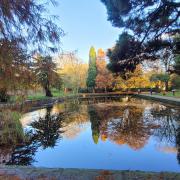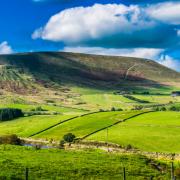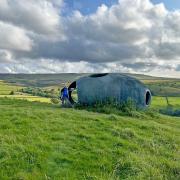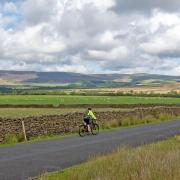Keith Carter gets muddy boots on his first visit to Worston, a quiet village near Clitheroe,

This walk was published in March 2015, so the details of the route may no longer be accurate, we do advise these articles should only be used as a guideline for any potential route you take and you should double check an up to date map before you set off.
My first walk to appear in Lancashire Life was in 2007 since when I have filed copy every month without fail, nearly a hundred walks covering the length and breadth of our county. It tickles me to write the words 'filed copy' which I have picked up from old movies like The Front Page and All the President's Men in which reporters are depicted as laconic guys in fedora hats, cigarette in the corner of their mouth as they type at great speed on upright Imperial typewriters. I prefer the laptop and my heart specialist insists I leave the cigarettes alone. The only filing of copy I do is to hit the button marked 'send'.

This will be my penultimate contribution to Lancashire Life since after the April issue I am to stand down. I have thought of myself as an ambassador for walkers, self-appointed admittedly, a role guide-book writers adopt, speaking for like-minded enthusiasts who take their pleasures from tramping over the landscape for the simple reason that it is there and they can do it.
Whenever walkers get together their conversation will often turn to places where they have walked and walks they have done. When I used to go out with walking groups I would have individuals pointed out to me as the one who had walked the GR20, climbed Kilimanjaro or done the Pennine Way, admirable achievements that earned the respect and envy of others. Now perhaps it will be said of me 'he used to write for Lancashire Life' although I can't imagine the information being greeted with gasps of awe.
During my eight years recording the footpaths of Lancashire Pendle Hill has often been on the route. The hill and its surrounding countryside are ideal for walkers with many alternative ways to explore the area but one I had not done before was to visit Worston. This can be done from Clitheroe town centre but on browsing through a box file of leaflets accumulated over the years I found one on the Geology Trail and this sparked my interest.
Salthill Quarry to the east of the town was used for the extraction of road stone exposing the multitude of fossils in the rocks here making it a mecca for geologists interested in such things as Waulsortian Mud Mounds and Ordovician Fossil Beds. What remains of the quarry is now hemmed in by factory units and industrial development but a well-intentioned attempt has been made to guide visitors around the site with interpretation panels explaining the geology to simple minds.

There are fossils in the loose rock left lying about and you are welcome to take pieces away within reason, though not bring your hammer and try to chip it out of the cliff. The fossils are mainly crinoids sort of stalky tubes, the name coming from the Greek for lily, krinon.
To start the walk, leave Clitheroe by the Chatburn Road then on reaching the first main roundabout turn right onto the Pimlico Link Road then right again into Lincoln Way. Pass the entrance to the auction mart and in a few hundred yards you will see cars parked nose in on the right which is where we can leave the car. Across the road is the entrance to Salthill Quarry Nature Reserve with a plan showing the way. This is also available as a map obtainable from the Tourist Information Centre in Clitheroe or as a download available online.
Follow the path to the top of the mound where there is a fine view of Pendle Hill from the vicinity of a stone bench decorated with carvings inspired by the fossils found at your very feet, left by the plant life that existed on this spot 340 million years ago. Where the path divides descend the mound to the left and on entering bushes a wall crosses our way.
Turn left and follow the enclosed path alongside a fence then on reaching a kissing-gate emerge onto the verge of the main road via a gate. Cross over to a stile opposite then turn down to the right on a broad, muddy track that brings us to an area of rough, poorly-drained grassland bordered by a stream. Keep forward beside this stream through two fields but look out for a footbridge crossing it and take it, turning left once you have crossed it. Climb the embankment ahead and we find ourselves on the verge of the terrifying A59. Wait for a gap then scuttle across to the far side where a signpost points the way, left, to Worston.
Follow the enclosed path that brings us to a lane at a gate with a stile beside it. Turn left and at a junction turn right to enter the quiet village of Worston, notable for the welcoming hostelry The Calf's Head, on the right hand side of the road as you start to leave the village.
Once through the village at a bend in the lane you notice a smart property with stone gateposts on the right with a footpath sign heading away from here through the yard by way of a stile leading into a rising field. Head up to the brow of this field holding to a line without straying too far to the right or left and in the top right hand corner there is a gate with, some yards to the left of it, a stile.
In the next field you should notice a grassed-over dip like an old boundary and this is the direction to keep to for the way ahead. A stream crosses our way forward with stepping stones to a gate improvised from heavy steel mesh. Farmers make gates out of anything to hand to avoid expense, old bed-heads, pallets, shed tin and, seen once, the door of a Peugeot 304, handle still in place. Follow a right hand fence line as far as a lone tree beyond which we come to a well-maintained access track and keep right to a junction of paths. One of these leads to Little Mearley Hall, the lone house seen to the left. I read somewhere, in Pevsner I think, that the bay window to the front elevation came from Whalley Abbey.
Our route is on a bridleway signposted to the right before the path crosses a stone bridge over a beck. In fact we follow the beck, keeping to the right of it, and staying with it as it curves to the left leaving us to continue between the beck and a wall. Go through two gates, turning right after the second one and remain with the beck as it twists and turns to create a series of those ox-bow bends we used to learn about in geography class.
Cross a footbridge when you come to one then head to a telegraph pole towards a series of several stiles. After crossing the fourth of these we meet a lane and turn right. This is the same lane we took earlier when we turned right towards Worston so we turn left to pick up our outward route and retrace our steps to the quarry, re-crossing the A59 and the link road and climbing back through the landscaped reserve the same way we came.
One word of warning: this route can get muddy. Most walkers take mud in their stride and accept the chore of washing off boots and gaiters under the tap. It's all part of this thing we do, walking. That leaves me with one more walk, my swansong. I wonder where it should be?
Compass points
Area of walk: Worston from Salthill Quarry
Distance: 4 miles
Time to allow: 2 hours
Map: OS Explorer OL41 Forest of Bowland and Ribblesdale
Refreshments: Calf's Head, Worston
Not suitable for wheelchair users or pushchair users.




